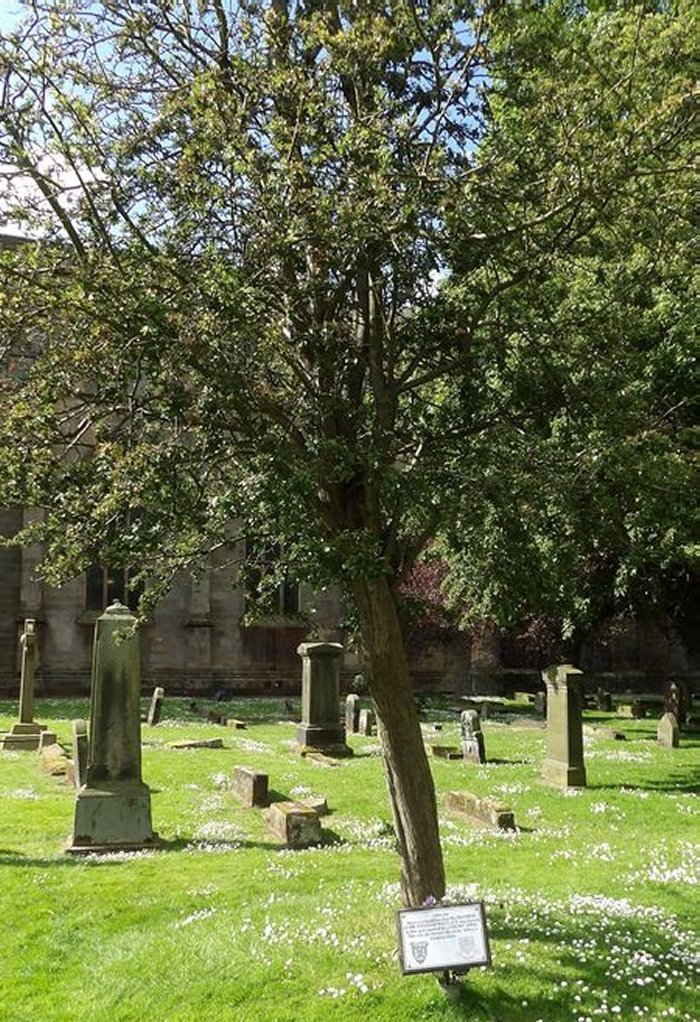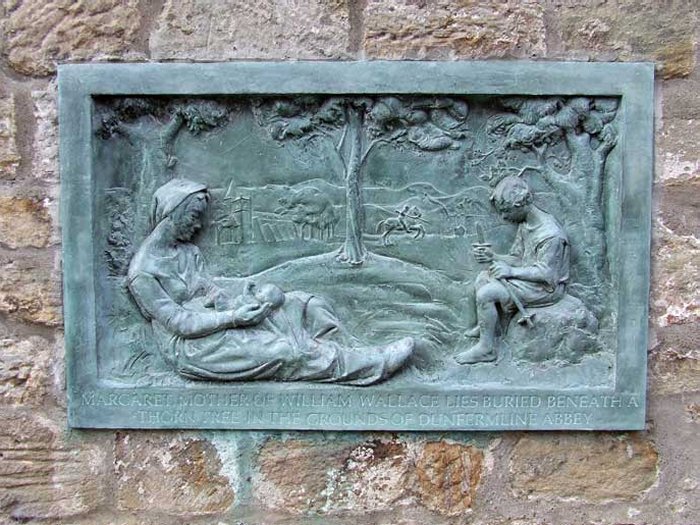MARGARET CRAUFURD OF CORSBIE |
 |
Many of the legends about William Wallace give his mother a prominent position. All the available evidence suggests that he was close to her, and that she was a significant presence throughout his life. He allegedly kept a missal with him that she had given him as a child, and it is possible that this may be the one he was described as reading from on the execution site at Smithfield. But how much do we really know about her? It is recorded that she was the daughter of Sir Reginald Craufurd, Sheriff of Ayr, that her brother was the priest of Dunipace, near Stirling, and that she resided for some time with a relative at Kilspindie Castle, in the Carse of Gowrie near Dundee. Most genealogies give her husband as being Malcolm Wallace of Elderslie, but Wallace's own seal (from the Lubeck letter) gives his father as Alan. According to the poet and chronicler Blind Harry, who claimed to have based his work on the diaries of John Blair, Wallace's biographer and chaplain, Wallace resided at the castle after the death of Alexander III in 1286, when he would have been approximately 12 - 16 years. Ross states that Wallace's mother took him there to stay with an old uncle. It is known that he attended school in Dundee, at the same time as Blair, and that is how the two knew each other. Blair entered the monastery at Dunfermline in the early 1290s, and in the Annals of Dunfermline, dated 1297, it is recorded that Arnold Blair, "a Monk of the Benedictine Cloister of Dunfermline," left the monastery and 'became chaplain to Sir William Wallace at the hero’s request'. Webster, in his history of Dunfermline Abbey, also records that Blair was a member of the Benedictine Order there. In Cowan and Henderson's "History of Everyday Life", Rebecca Boorsma comments "the chronicle stereotype limited the role of Scottish women for generations to come. Ewan, in her discussion on the progress of women's history ('Gendering Scottish History' p27) claims that this stereotype has stunted the perception of women, resulting in 'few strong female figures' comparable to Wallace or Bruce. Women have thus become unworthy of attention because of their passive, docile natures..." However, Boorsma qualifies this generality by stating that "On the other hand, The Bruce and The Wallace, which represent women as active participants, modify the view of the weak female character." Sadly, neither Wallace or his mother feature in Barbour's epic poem. Aside from the various (and varied) genealogical records, Margaret's main appearance in any known surviving records seems to have involved her flight from Kilspindie to Dunfermline around 1296, when Wallace, still at school in Dundee, slew the governor Selby's son in a quarrel and fled towards the Carse of Gowrie. Hutcheson makes reference to a manuscript in the possession of Mr Paterson of Castle Huntly, dating from around 1760, which he quotes extensively and verbatim. "The first halt he made was at a house in Lonforgan and sat Down at the Door of said house on a stone which serves for a knocking stone and hear the Hospitall Landlady give him an ample repast of Bread and Milk. from there he proceeded to Killspindie, but his Uncle fearing a Search from Dundie sent our young Hero with his wife over the ferry at Lindors on their way to Dinipce in Stirllingshire where he was safe at that time." This flight is also mentioned by both Blind Harry and Peter Langtoft in his chronicle, though with a difference in dates. Blind Harry (Book I, Chapter III) places the flight around 1296, immediately after the killing of Selby's son - "His mother clad herself in pilgrim's weed, then him disguis'd, and both marched off with speed; ... Close by Lindores, the ferry o'er they past; then through the Ochell marched very fast". Langtoft dates this to 1303, “His modyr graithit (1) hir in pilgrim weid; (2) Hym (selff) disgysyt, syne glaidlye with hir yeid, (3) A schort swerd (4) wndyr his weid (5) priuale, In all that land full mony fays (6) had he. Baith on thar fute, with tham may tuk thai nocht Quha sperd, she said to Sanct Margret thai socht, Quha serwit hir. Full gret frendschipe thai fand With Sothroun folk, for scho was of Ingland. Besyde Landoris the ferrye oure thai past, Syne throw the Ochell sped theim wondyr fast. In Dunfermlyn thai lugyt all that nicht. (Langtoft’s Chronicle, p. 322.) (1) Dressed (2) Pilgrim dress (3) Went, or travelled (4) Sword (5) Dress, Privately (6) Foes The Pittencrieff Park leaflet states that in 1303 he visited Dunfermline, supposedly to St. Margaret’s Shrine, with his mother. Tradition has it that his mother would later die in Dunfermline on one of her son’s flights and that she was hastily buried at the spot in the Abbey’s graveyard marked by The Thorn Tree. Blind Harry (Book X, Chapter III) describes Margaret Craufurd being in Dunfermline as a pilgrim when she died and was buried there. From the Annals of Dunfermline - 'From this period downward to the present time a tradition has held its ground that the mother of Wallace died at Dunfermline on some one of her son’s flights, and that she was hastily buried at a spot, now in the northern churchyard, marked by a thorn tree' ... 'If the mother of Wallace was interred at Dunfermline, she would be, no doubt, interred within the consecrated walls of the Abbey Church. As the tradition continues so firm, we are inclined to believe that the body of the mother of Scotland’s great and true-hearted patriot rests in peace within the consecrated walls of the church, where the daily service was conducted, and not in the place pointed out where unknown strangers were interred. If this tradition is correct, the interment must have taken place a few weeks only before Edward and his Court took up their winter quarters in the Monastery; and when the haughty monarch heard of it, and of the hand the Abbot and the monks would have in the interment, this may have been one of the causes which induced him to fire the Monastery at his leaving it' ... 'So far as we have been able to ascertain, this visit is the fourth one of Edward to Dunfermline: the first, in 1291, the second and third, in 1296; and the fourth, in 1303.' It is affirmed by other sources that Longshanks wintered in Dunfermline from November 1303 to February 1304. From both the Annals and Langtoft:- During 1303 William Wallace made “the forest of Dunfermline his hiding-place.” At this period 'the glen of Pittencrieff was an almost impenetrable forest, extending from the low grounds on the south to Balrig Burn (Baldredge Burn) on the north'. 'There were also other forests of a lesser degree, such as Fothrich Moor or forest, &c.; but the forest of Dunfermline would most likely be in the former locality, and St. Margaret’s Cave (the Cave Well) may have been his place of shelter.' 'In the forest of Dunfermline the renowned Wallace appears to have had conferences with his friends as to the propriety of delivering himself up to Edward of England on honourable terms.' When these were made known to Edward, he got "infuriated", cursed him by the "well known fiend", denounced him as "a traitor", and set a price of 300 merks on his head. 'In 1304 Edward I occupied Dunfermline Abbey. He burned it when he left. It is generally thought that Margaret was buried there shortly before his arrival. That may have been the reason she was buried outside, providing an anonymous grave safe from a rageful revenge which would likely have ensued had she been buried in the consecrated area inside the church, as would have been expected in more peaceful times.' And there we have it - sadly, containing a bit more speculation than actual hard fact, due to the serious dearth of reliable source material. However, local tradition has often proved in the past to be more soundly based on fact than fiction when reliable sources have been later discovered - we can only hope that some such sources survive, to be discovered in the future. Nevertheless, our Scots tradition has been kind to Margaret Wallace - she may be a shadowy figure in historical terms, but is still fondly remembered both locally and nationally. There are worse ways to leave your mark on our nation... For Annette, who suggested it was time to honour our hero's mother. |
 |
Plaque on the west wall of the garden at the rear of the Abbot's House, depicting Margaret Crawford, holding William's little brother John, with William opposite carving a wooden sword. There is a thorn tree in the background, and the plaque states "Margaret, mother of William Wallace, lies buried beneath a thorn tree in the grounds of Dunfermline Abbey". |
|
Bibliography Bain, Joseph. 'Calendar of Documents relating to Scotland, Volume 2 (1272-1307)', H.M. General Register House, Edinburgh, 1884 Cowan, Edward J. (Ed). 'The Wallace Book', Birlinn, Edinburgh, 2007 Cowan,E, and Henderson, L. (Eds) 'A History of Everyday Life in Medieval Scotland, 1000 to 1600', Edinburgh University Press, 2011 Henderson, Ebenezer. 'The Annals of Dunfermline and vicinity - from the earliest Authentic Period to the Present Time A.D. 1069 - 1878', John Tweed, Glasgow, 1879 Hutcheson, Alexander. 'Proceedings of the Society of Antiquities in Scotland, III. Notice of the Wallace Stones, Longforgan', May 14, 1900 Langtoft, Peter. "Chronicle of England, Part 3: The Reign of Edward I". Cambridge Digital Library. Retrieved 10th December 2020 Pittencrieff Park restoration project leaflet, supported by the Carnegie Dunfermline Trust and Fife Council (local publication) c. 2018 Ross, David R. 'Desire Lines', Luath Press, Edinburgh, 2004 Ross, David R. 'Women of Scotland', Luath Press, Edinburgh, 2010 Stevenson, Joseph. 'Documents Illustrative of Sir William Wallace, His Life and Times', Issue 54 of Publications, Maitland Club, Glasgow, 1841 Webster, J.M. 'Dunfermline Abbey', Carnegie Dunfermline Trust, 1948 |
| © Society of William Wallace 2007-2026 | The Society of William Wallace is a Scottish Charitable Incorporated Organisation Registration number SC045959 |
